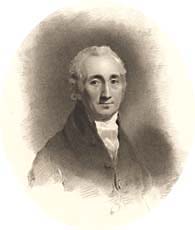|
|
Home | Corson
Collection | Biography | Works | Image
Collection | Recent Publications | Portraits | Correspondence | Forthcoming
Events | Links | E-Texts | Contact
School and University
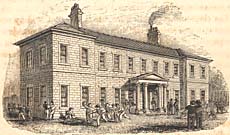 On
his return from Sandyknowe, Scott was privately
educated in preparation for the High School of Edinburgh (now the
Royal High School), which he entered in October 1779. The School
had just moved into its new building on Infirmary Street (portrayed
left), now the seat of Edinburgh University's Department of Archaeology.
Scott initially felt at something of a disadvantage, for although
he was a year older than most of his classmates, his knowledge of
Latin, the staple of the school's curriculum, was markedly inferior.
Soon, however, he had bridged the gap and became a competent if
never brilliant scholar. He was popular with his schoolfellows who
admired his refusal to let his lameness prevent him from participating
in their boisterous playground games. The young Scott was already
a tireless walker, endlessly exploring the streets of the Old Town
and familiarizing himself with the terrain that was to feature in
The Heart of Midlothian
and Redgauntlet. On
his return from Sandyknowe, Scott was privately
educated in preparation for the High School of Edinburgh (now the
Royal High School), which he entered in October 1779. The School
had just moved into its new building on Infirmary Street (portrayed
left), now the seat of Edinburgh University's Department of Archaeology.
Scott initially felt at something of a disadvantage, for although
he was a year older than most of his classmates, his knowledge of
Latin, the staple of the school's curriculum, was markedly inferior.
Soon, however, he had bridged the gap and became a competent if
never brilliant scholar. He was popular with his schoolfellows who
admired his refusal to let his lameness prevent him from participating
in their boisterous playground games. The young Scott was already
a tireless walker, endlessly exploring the streets of the Old Town
and familiarizing himself with the terrain that was to feature in
The Heart of Midlothian
and Redgauntlet.
| Scott thought his first-year tutor Luke Fraser
something of a pedant. He took much greater pleasure in learning
when in 1780 he entered the class of the rector, Dr Alexander
Adam (1741-1809). Adam, one of the most innovative educators
of his age, sought to instill in his pupils not only a grasp
of grammar but a sensitivity to literary language. With Adam's
encouragement, the young Scott translated Horace and Virgil
into English verse and made his first attempts at original composition. |
|
His education was not confined to the school day. Together with
chivalric romances and the poems of Spenser, Ariosto, and Boiardo,
Scott was already a voracious reader of history and books of travel.
His father had also engaged a private tutor, James Mitchell, to
teach him arithmetic and writing (not part of the High School's
curriculum). Mitchell, a fiery defender of the Kirk, found time
to verse Scott in church history and in the travails of the Covenanters,
lessons which would eventually bear fruit in Old
Mortality.
|
|
During his last year at the High School, Scott
had put on several inches -- as an adult he was over six feet
tall -- and his family feared that he was outgrowing his strength.
Before sending him to college, they therefore decided that he
should spend half-a-year with his Aunt Jenny in Kelso building
up his constitution. He was to keep up his Latin while at Kelso
by attending the local Grammar School, picturesquely set in
the shadow of the ruined abbey (left). |
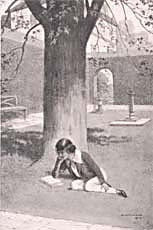 Here
he made one of the most significant friendships of his life. Among
his classmates was the son of a local shop-keeper, James
Ballantyne, Scott's future business-partner and printer of his
major works. It was also at Kelso, which was equipped with well-stocked
circulating and subscription libraries, that Scott discovered the
eighteenth-century novel, delighting in the works of Richardson,
Fielding, Smollett and Mackenzie. His most pleasurable encounter,
however, was with Bishop Percy's great ballad-collection Reliques
of Ancient English Poetry. For Scott, it was a revelation that
a distinguished scholar could share his enthusiasm for popular poetry
and consider it a subject for serious research. The Reliques
would later provide the model for Scott's first important publication
The Minstrelsy of
the Scottish Border. Here
he made one of the most significant friendships of his life. Among
his classmates was the son of a local shop-keeper, James
Ballantyne, Scott's future business-partner and printer of his
major works. It was also at Kelso, which was equipped with well-stocked
circulating and subscription libraries, that Scott discovered the
eighteenth-century novel, delighting in the works of Richardson,
Fielding, Smollett and Mackenzie. His most pleasurable encounter,
however, was with Bishop Percy's great ballad-collection Reliques
of Ancient English Poetry. For Scott, it was a revelation that
a distinguished scholar could share his enthusiasm for popular poetry
and consider it a subject for serious research. The Reliques
would later provide the model for Scott's first important publication
The Minstrelsy of
the Scottish Border.
 In
November 1783, Scott was called home to study classics at Edinburgh
University. At only twelve years old, he was a year or so younger
than most of his classmates. An initial sense of inferiority was
heightened by his ignorance of Greek. With overpopulated lecture-rooms,
no tutorials, and uninspiring teaching, there was little hope of
him catching up with his peers. At the end of his first session,
Scott scandalized his Greek lecturer, Professor Dalzell, by handing
in an essay arguing that Ariosto was a superior poet to Homer. He
nonetheless became popular with his fellow students, making a number
of acquaintances which would prove influential in his professional
life as a lawyer, including William Rae, future Lord Advocate, and
Archibald Campbell, later judge of the Court of Session. Scott initially
spent two years at the College, interrupted by an illness necessitating
a further stay at Kelso. Then in March 1786, he began his apprenticeship
to the profession of Writer to the Signet in his father's office
(see Professional Life). In
November 1783, Scott was called home to study classics at Edinburgh
University. At only twelve years old, he was a year or so younger
than most of his classmates. An initial sense of inferiority was
heightened by his ignorance of Greek. With overpopulated lecture-rooms,
no tutorials, and uninspiring teaching, there was little hope of
him catching up with his peers. At the end of his first session,
Scott scandalized his Greek lecturer, Professor Dalzell, by handing
in an essay arguing that Ariosto was a superior poet to Homer. He
nonetheless became popular with his fellow students, making a number
of acquaintances which would prove influential in his professional
life as a lawyer, including William Rae, future Lord Advocate, and
Archibald Campbell, later judge of the Court of Session. Scott initially
spent two years at the College, interrupted by an illness necessitating
a further stay at Kelso. Then in March 1786, he began his apprenticeship
to the profession of Writer to the Signet in his father's office
(see Professional Life).
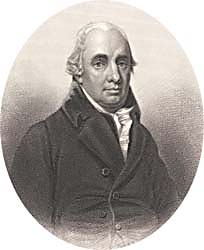 When
it was subsequently decided that Scott should aim for the Bar rather
than follow his father's career, he resumed his university studies.
Before taking up the formal study of Law, he attended classes in
Moral Philosophy and Universal History in 1789-90. The former was
taught by the charismatic Dugald Stewart (1753-1828) who combined
the Scottish 'Common Sense' tradition with elements of empiricism.
Believing that the true object of moral philosophy was the study
of man in society, Stewart argued that human welfare could be advanced
by following universal ideals of truth and virtue. Scott was skeptical
of Stewart's belief that irrational institutions and customs could
be clinically eliminated, maintaining that these developed in an
organic fashion and could not be uprooted without inflicting moral
and emotional damage. Nonetheless, Stewart's stress on man as a
social being, his view of society as a constantly evolving mechanism,
and his faith in universal, trans-historical values would all play
their part in the development of Scott's own philosophy of history. When
it was subsequently decided that Scott should aim for the Bar rather
than follow his father's career, he resumed his university studies.
Before taking up the formal study of Law, he attended classes in
Moral Philosophy and Universal History in 1789-90. The former was
taught by the charismatic Dugald Stewart (1753-1828) who combined
the Scottish 'Common Sense' tradition with elements of empiricism.
Believing that the true object of moral philosophy was the study
of man in society, Stewart argued that human welfare could be advanced
by following universal ideals of truth and virtue. Scott was skeptical
of Stewart's belief that irrational institutions and customs could
be clinically eliminated, maintaining that these developed in an
organic fashion and could not be uprooted without inflicting moral
and emotional damage. Nonetheless, Stewart's stress on man as a
social being, his view of society as a constantly evolving mechanism,
and his faith in universal, trans-historical values would all play
their part in the development of Scott's own philosophy of history.
|
Equally significant were Alexander Fraser Tytler's lectures
on Universal History. Tytler (1747-1813) impressed Scott with
his distrust of grandiose, universal schemes of history and
his horror of generalizations. An empiricist in the tradition
of Hume, he emphasized the role of institutions, heredity,
and environment as the shaping forces of history. Through Stewart
and Tytler, then, Scott came into contact with Enlightenment
approaches to history and sociology. In his fiction, these
would be brought to bear on the oral, folk traditions that
he had absorbed at Sandyknowe and Kelso. |
Links
Back to Biography Index
Last updated: 28-Nov-2011
© Edinburgh University Library
|
|

 On
his return from
On
his return from 
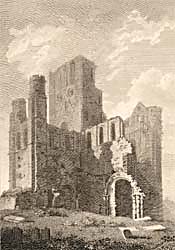
 Here
he made one of the most significant friendships of his life. Among
his classmates was the son of a local shop-keeper,
Here
he made one of the most significant friendships of his life. Among
his classmates was the son of a local shop-keeper,  In
November 1783, Scott was called home to study classics at Edinburgh
University. At only twelve years old, he was a year or so younger
than most of his classmates. An initial sense of inferiority was
heightened by his ignorance of Greek. With overpopulated lecture-rooms,
no tutorials, and uninspiring teaching, there was little hope of
him catching up with his peers. At the end of his first session,
Scott scandalized his Greek lecturer, Professor Dalzell, by handing
in an essay arguing that Ariosto was a superior poet to Homer. He
nonetheless became popular with his fellow students, making a number
of acquaintances which would prove influential in his professional
life as a lawyer, including William Rae, future Lord Advocate, and
Archibald Campbell, later judge of the Court of Session. Scott initially
spent two years at the College, interrupted by an illness necessitating
a further stay at Kelso. Then in March 1786, he began his apprenticeship
to the profession of Writer to the Signet in his father's office
(see
In
November 1783, Scott was called home to study classics at Edinburgh
University. At only twelve years old, he was a year or so younger
than most of his classmates. An initial sense of inferiority was
heightened by his ignorance of Greek. With overpopulated lecture-rooms,
no tutorials, and uninspiring teaching, there was little hope of
him catching up with his peers. At the end of his first session,
Scott scandalized his Greek lecturer, Professor Dalzell, by handing
in an essay arguing that Ariosto was a superior poet to Homer. He
nonetheless became popular with his fellow students, making a number
of acquaintances which would prove influential in his professional
life as a lawyer, including William Rae, future Lord Advocate, and
Archibald Campbell, later judge of the Court of Session. Scott initially
spent two years at the College, interrupted by an illness necessitating
a further stay at Kelso. Then in March 1786, he began his apprenticeship
to the profession of Writer to the Signet in his father's office
(see  When
it was subsequently decided that Scott should aim for the Bar rather
than follow his father's career, he resumed his university studies.
Before taking up the formal study of Law, he attended classes in
Moral Philosophy and Universal History in 1789-90. The former was
taught by the charismatic Dugald Stewart (1753-1828) who combined
the Scottish 'Common Sense' tradition with elements of empiricism.
Believing that the true object of moral philosophy was the study
of man in society, Stewart argued that human welfare could be advanced
by following universal ideals of truth and virtue. Scott was skeptical
of Stewart's belief that irrational institutions and customs could
be clinically eliminated, maintaining that these developed in an
organic fashion and could not be uprooted without inflicting moral
and emotional damage. Nonetheless, Stewart's stress on man as a
social being, his view of society as a constantly evolving mechanism,
and his faith in universal, trans-historical values would all play
their part in the development of Scott's own philosophy of history.
When
it was subsequently decided that Scott should aim for the Bar rather
than follow his father's career, he resumed his university studies.
Before taking up the formal study of Law, he attended classes in
Moral Philosophy and Universal History in 1789-90. The former was
taught by the charismatic Dugald Stewart (1753-1828) who combined
the Scottish 'Common Sense' tradition with elements of empiricism.
Believing that the true object of moral philosophy was the study
of man in society, Stewart argued that human welfare could be advanced
by following universal ideals of truth and virtue. Scott was skeptical
of Stewart's belief that irrational institutions and customs could
be clinically eliminated, maintaining that these developed in an
organic fashion and could not be uprooted without inflicting moral
and emotional damage. Nonetheless, Stewart's stress on man as a
social being, his view of society as a constantly evolving mechanism,
and his faith in universal, trans-historical values would all play
their part in the development of Scott's own philosophy of history.